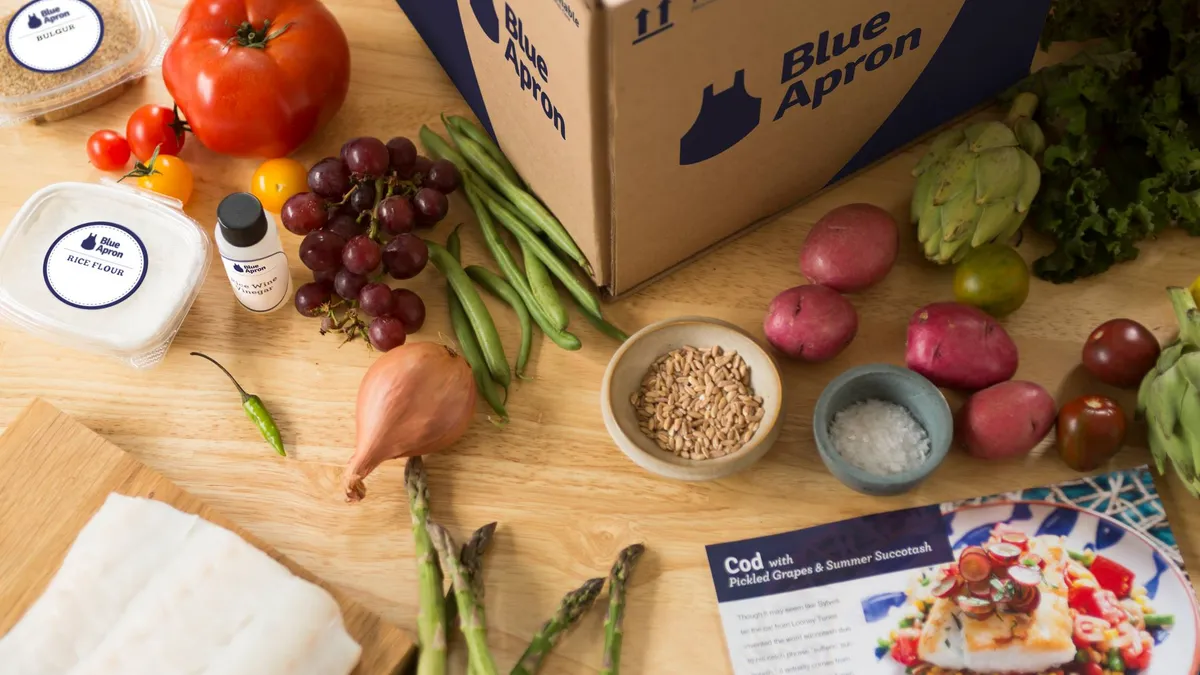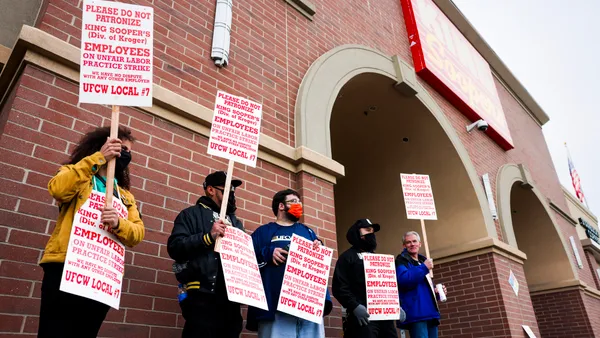Dive Brief:
- Blue Apron’s stock price has fallen below $1, a historic low for the meal kit company in a series of record lows. The stock has dropped more than 75% since July and has lost 90% of its original value since the company went public last year.
- The company missed Q2 and Q3 earnings targets this year. A 24% drop in customers led to a loss of $32.8 million in the second quarter, and after poor third-quarter earnings in November, Blue Apron said it would cut its workforce by 4% to help with profitability. Quarterly results have led to several downgrades.
- Blue Apron has attempted to forge partnerships with retailers to boost its business, but a pilot project with Costco has been halted for the holidays. Blue Apron says it will resume the partnership and seek others in the new year. The company also began selling its meal kits on Jet.com last month to customers in the greater New York City area.
Dive Insight:
It has been a tough year for Blue Apron, and the challenges keep mounting as the stock spirals downward. Bloomberg reported that Blue Apron is the third worst IPO of the past decade, and is at risk of being de-listed.
There is some talk that another company, presumably a retailer, might swoop in and acquire Blue Apron — and that this is the company’s best hope for survival. A buyout could stop Blue Apron's stock freefall and steady the business. And the company could probably be purchased at an attractively low price and help a retailer expand its offerings with a well-known brand. But the question is, would a retailer see enough value in in-store sales to shoulder the ailing online subscription business?
Meal kits have shown promising sales so far in supermarkets. Nielsen notes that in-store meal kit sales hit $155 million last year and are on track to grow magnitudes larger this year, while Albertsons' internal research has found 80% of customers would welcome seeing them on shelves. But meal kits' staying power in ever-evolving prepared foods departments is far from proven at this point.
Despite struggles with the meal kit business model, research shows the market is still ripe for growth. Nielsen found that meal kit spending is rising three times faster than digital delivery or grocery e-commerce, and there is potential to reach 30 million household customers in the U.S. Another report found that meal kit subscriptions grew 67% over the last year.
The future of the meal kit may be in grocery stores. A few top grocers have acquired meal kit services this year, and while meal kit companies have faced scrutiny over cost, wasteful packaging and delivery schedules, grocers can repurpose them as quick meal solutions that shoppers can easily grab at the last minute. Meal kit companies would be wise to seek buyers, which can offer them immediate, broad distribution and steady financial backing.
Among some of the recent acquisitions, Albertsons bought Plated last year and introduced the meal kits into its stores in the spring. Kroger, which offers its own DIY meal kit section, purchased Home Chef for $200 million in June and immediately brought the kits to store shelves. HelloFresh acquired meal kit competitor Green Chef in April. Other retailers and food brands have been creative in their entry to the meal kit business. Publix, Walmart and Stouffer’s and have all launched their own line of meal kits to sell in grocery stores. Even Chick-Fil-A has dipped its toes into the category, recognizing the threat that meal kits may present to restaurants and the demand for takeout.
High customer acquisition costs and fickle loyalty have plagued meal kit companies. Chef’d, which seemed to have a well structured approach focused on both online and store sales, met its demise in July after failing to secure funding and was recently acquired by True Food Innovations.
Blue Apron has implemented cost-cutting measures while targeting promising opportunities like the Jet and Grubhub partnerships. These are necessary steps for the struggling company, but stabilizing the ship and growing the business are two very different prospects for Blue Apron, with the latter option looking increasingly difficult.
"We continue to see longer-term value from the capabilities the company has developed and the attractive Blue Apron brand, but still are less clear on the standalone profitability profile of the business," Rupesh Parikh, a senior research analyst with Oppenheimer & Co., wrote in a note to investors last month following a meeting with Blue Apron's CEO Brad Dickerson.













